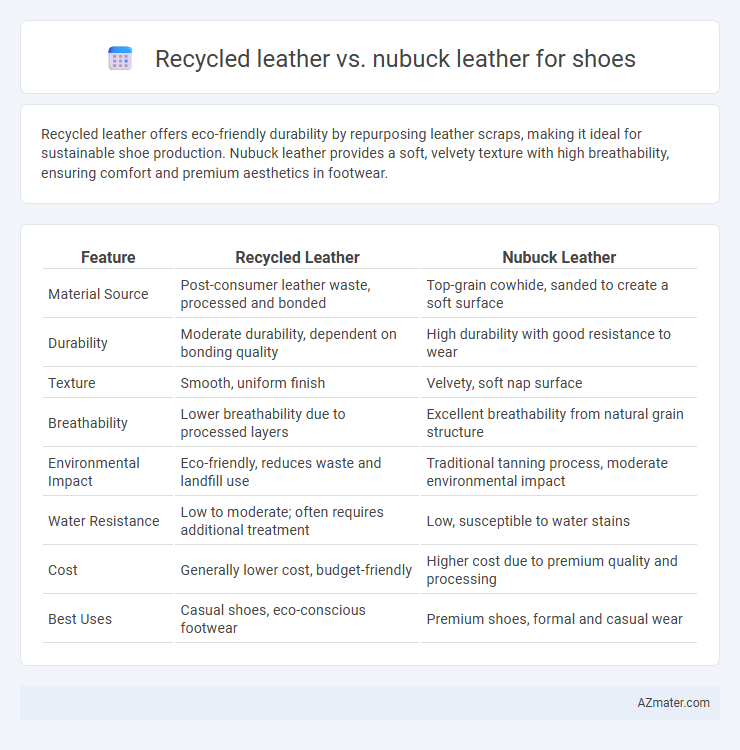Recycled leather offers eco-friendly durability by repurposing leather scraps, making it ideal for sustainable shoe production. Nubuck leather provides a soft, velvety texture with high breathability, ensuring comfort and premium aesthetics in footwear.
Table of Comparison
| Feature | Recycled Leather | Nubuck Leather |
|---|---|---|
| Material Source | Post-consumer leather waste, processed and bonded | Top-grain cowhide, sanded to create a soft surface |
| Durability | Moderate durability, dependent on bonding quality | High durability with good resistance to wear |
| Texture | Smooth, uniform finish | Velvety, soft nap surface |
| Breathability | Lower breathability due to processed layers | Excellent breathability from natural grain structure |
| Environmental Impact | Eco-friendly, reduces waste and landfill use | Traditional tanning process, moderate environmental impact |
| Water Resistance | Low to moderate; often requires additional treatment | Low, susceptible to water stains |
| Cost | Generally lower cost, budget-friendly | Higher cost due to premium quality and processing |
| Best Uses | Casual shoes, eco-conscious footwear | Premium shoes, formal and casual wear |
Introduction to Recycled Leather and Nubuck Leather
Recycled leather, made from repurposed leather scraps bonded together, offers an eco-friendly alternative for shoe manufacturing by reducing waste and minimizing environmental impact. Nubuck leather, characterized by its soft, velvety surface created through sanding the outer layer of full-grain leather, provides durability and a premium aesthetic ideal for stylish footwear. Both materials balance functionality and design, with recycled leather emphasizing sustainability and nubuck leather focusing on texture and luxury.
Material Composition: What Sets Them Apart
Recycled leather consists of shredded leather fibers bonded with polyurethane or latex, creating a sustainable material that retains the look and feel of genuine leather while minimizing waste. Nubuck leather is made from the outer layer of high-quality cowhide, sanded or buffed to produce a soft, velvety surface with a fine nap, offering durability and a premium texture. The key distinction lies in recycled leather's eco-friendly composition using reclaimed fibers versus nubuck's solid natural leather origin and characteristic brushed finish.
Sustainability and Environmental Impact
Recycled leather reduces waste by repurposing leather scraps, lowering landfill contribution and conserving natural resources compared to traditional leather production. Nubuck leather, while durable and biodegradable, requires significant water and chemical use during processing, increasing its environmental footprint. Choosing recycled leather supports circular economy practices and decreases pollution, making it a more sustainable option for eco-conscious footwear.
Durability and Longevity Comparison
Recycled leather offers moderate durability with a layered structure that combines genuine leather fibers and synthetic materials, making it resistant to wear but prone to cracking over time. Nubuck leather, derived from the outer side of a hide and sanded for a soft, velvety texture, provides superior strength and longevity due to its dense grain and natural resilience. For shoe applications, Nubuck leather generally outperforms recycled leather in durability and long-term use, maintaining appearance and structural integrity through extended wear.
Comfort and Breathability in Shoes
Recycled leather offers moderate comfort and breathability in shoes due to its composite material structure, which may limit airflow compared to natural fibers. Nubuck leather, derived from top-grain cowhide, provides superior comfort thanks to its soft, velvety texture and enhanced breathability that helps regulate foot temperature. For footwear focused on prolonged wear and moisture management, Nubuck leather typically outperforms recycled leather in both comfort and breathability.
Aesthetic Appeal: Look and Texture
Recycled leather offers a unique, eco-friendly aesthetic with a smooth, polished finish that mimics traditional leather while incorporating visible fibers, creating a distinct textured look. Nubuck leather features a velvety, matte surface achieved by sanding the grain side, providing a soft touch and a subtle, luxurious appearance that ages gracefully with wear. Both materials present a premium look, but recycled leather appeals to sustainable fashion enthusiasts, whereas nubuck leather attracts those seeking classic elegance and texture depth in footwear.
Price Differences and Market Availability
Recycled leather shoes generally offer a more budget-friendly option compared to Nubuck leather due to lower production costs and the use of repurposed materials, leading to higher affordability in mass markets. Nubuck leather, valued for its soft, velvety texture and durability, commands premium pricing and is often found in higher-end, specialty footwear stores with limited market availability. Consumers seeking cost-effective, eco-friendly footwear frequently choose recycled leather, whereas those prioritizing luxury and long-lasting wear predominantly prefer Nubuck leather shoes.
Maintenance and Care Requirements
Recycled leather requires less intensive maintenance, often needing only regular cleaning with a damp cloth and occasional conditioning to preserve its durability and prevent cracking. Nubuck leather demands more careful care, including gentle brushing with a suede brush to remove dirt and prevent stains, along with specialized nubuck sprays to maintain its texture and water resistance. Both types benefit from avoiding prolonged exposure to moisture and direct sunlight to extend shoe lifespan.
Ideal Use Cases for Shoes
Recycled leather offers durability and eco-friendliness, making it ideal for everyday casual shoes and sustainable fashion footwear. Nubuck leather, known for its soft texture and premium appearance, suits high-end sneakers, dress shoes, and stylish boots requiring breathability and comfort. Shoes used in wet or rough outdoor conditions benefit from recycled leather's resistance, while nubuck excels in dry environments where aesthetic appeal is prioritized.
Choosing the Right Leather: Factors to Consider
When choosing between recycled leather and nubuck leather for shoes, consider durability, environmental impact, and texture preferences. Recycled leather offers eco-friendly benefits by repurposing waste materials, while nubuck leather provides a soft, velvety finish with high breathability but requires more maintenance. Assess your priorities for sustainability, wear resistance, and aesthetic appeal to select the most suitable leather type.

Infographic: Recycled leather vs Nubuck leather for Shoe
 azmater.com
azmater.com